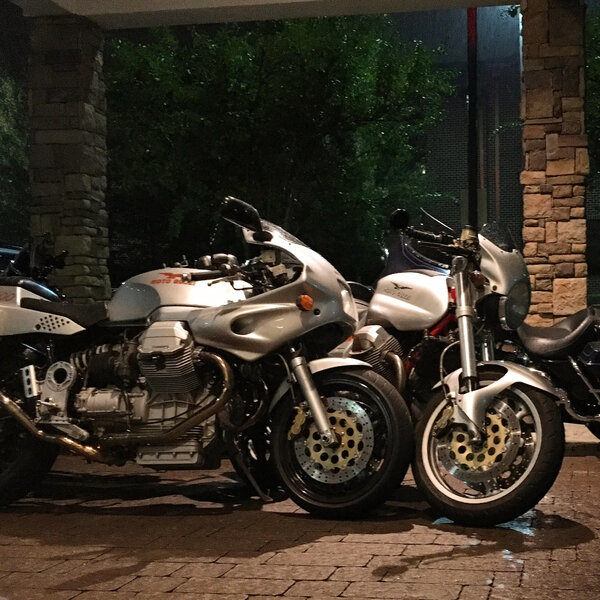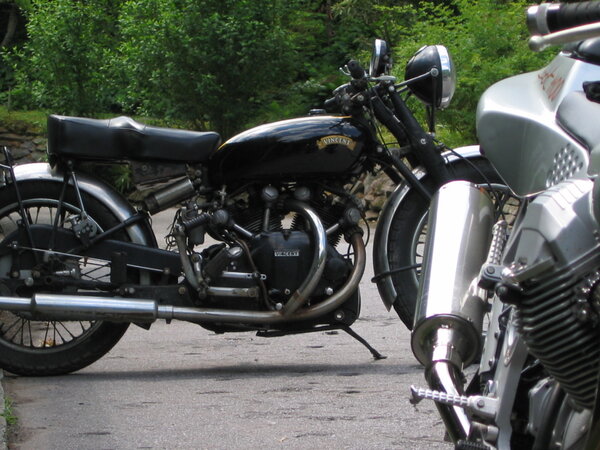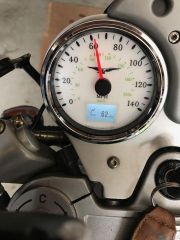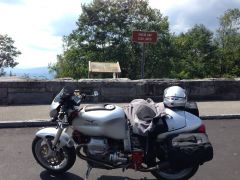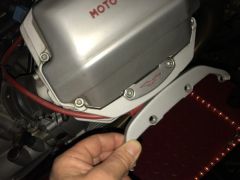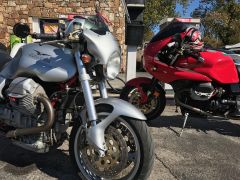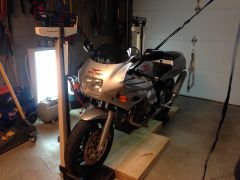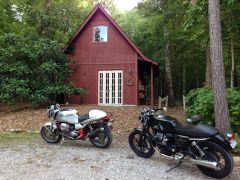Leaderboard
Popular Content
Showing content with the highest reputation on 05/26/2022 in all areas
-
Time permitting, a spritz with Kroil or other penetrant and patience will help extract broken bolts. As well dad taught me decades ago to use anti-seize compound on fasteners which might suffer from electrolysis or road grime. The plugs on his Continental C85 were so treated. Bolts that protrude out the backside can also have their threads covered with the small vinyl caps that are sold with children's toys etc.2 points
-
I did all the purchases from "The nut place" 6605 Gessner Road, Houston, TX 77040-4015; They have all metric fasteners in stock, stainless too, they also have a machine shop, they can do fabrication. Nice and friendly people. I recommend.2 points
-
I got it out using the "jam nut" technique. I also understood why the head broke. I purchased stainless replacement M8 x 40 mm long CHC screws, but the passenger foot peg holding bracket is not in line with the threaded hole. I need to untighten the other screw to align the hole with the thread. I need to remove the seat skirt to access the other screw though.2 points
-
I have not taken the cartridge apart on ours, but it was clearly a cartridge and not a damper rod set up. The valving appears to be shims on a piston, but it has been a while. And I am not sure how the adjusters worked. It is possible that the valving is stationary and the piston has not valving, it just forces the oil through the stationary valving at one end of the cartridge. I don't know, I did not open the cartridge. It was not required for what I was doing. Again, it has been years since I worked on it. I do know the cartridge had a pair of holes in it that allowed the oil to bypass the valving in the piston. And by blocking off one of those two holes I forced more oil to go through the valving and thus the adjuster had a noticeable effect, while previously with both holes open the adjuster had no effect until the piston moved past at least one of the two holes. So as designed the adjusters were only effective in the last inch or so of travel, something of an adjustable hydraulic bumpstop. The dampening was separate, one leg had valving in that piston that worked in compression and the other had valving that worked in extension (rebound). In the compression side there was no valving to slow oil from flowing from above the piston to below the piston, and on the other side there was no valving to slow the oil from below the piston to above the piston. There was only valving in one direction. But again, all this was taking place in a separate cartridge inside the fork and not using a damper rod at the bottom of the fork. They may have a different design for the cartridge than later forks, but it is a cartridge.2 points
-
Well this might be a complicated discussion. The early 40mm forks from what I have seen of them ( and I haven't had them apart unlike the later forks) control the compression and rebound via fixed orifice ports, correct? The damper piston operates in a sleeve that's bolted to the fork slider at the bottom. Further studying of the manual images it appears the early forks are indeed cartridge types and are able to be disassembled. What I dont know is does the damper rod piston and the "foot valve" ( which could be the compression damping valve but could just be a bottoming out snubber) as described in the manual have genuine shim stacks damping control? As soon as I saw and read from years ago the damping was controlled via fixed orifices and people were modifying them by welding up the holes and re drilling them I labelled them in my head as damper rod forks. This combined with no aftermarket replaceable cartridges for them cemented this impression in my mind. They appear from the images to be a cartridge "style" but is the damping controlled by fixed orifices or shim stacks on piston rod and a compression valve assy?2 points
-
Ok so I've had to delete my last post on this because it was wrong. I have established without doubt that the later V11 sport triple clamps are indeed "canted" or more correctly have a built in negative rake. You can fairly easily check what your bike has by a measurement insitu. I have a new set of the later black triples and you can confirm by measuring the steering stem hole location in the bottom clamp. If you measure from the edge of the stem hole OD to the front and aft edges of the oval flat face the newer raked clamps measure 11mm and 16mm respectively where the older 0 rake forks measure 13mm and 14mm. So Guzzi have moved the stem forward 2mm in the new lower triple clamps effectively steepening the angle in the lower clamp and left the top clamp the same. So 40mm offset on the top clamp and 38mm for the lower. They have of course machined the fork leg bores at a fractional angle to allow for this so you cant mix and match new and old clamps. Here's an image of a later clamp base and you can see the stem hole is obviously off set on the machined flat face. The earlier lower clamps have the stem hole more centred by 2mm. The effect of this negative offset is to give the bike more trail. How much I don't know but it may also clear up some of the wheel base question marks as well between the bikes which I think have been discussed aside from the long/short frame variations.2 points
-
It's a .pdf so it won't share the picture https://www.msf-usa.org/downloads/Street_Motorcycle_Tips.pdf1 point
-
She asked me (Stefanie) how I came to know about their Museum. I said the Motorcycle Tour of Texas... her face lit up, and she said she knew all about it. I liked they kept that roll of paper which was anonymously annotated to be the last one produced from the mill before it shut down.1 point
-
I recall the recommendation that stainless steel fastener threads be coated with a grease or sealant to inhibit corrosive bimetal electrolysis when screwed into aluminum (the aluminum becomes sacrificial). I wonder if similar applies to stainless steel screwed into steel?1 point
-
1 point
-
Yeah, Petrucci's version doesn't seem to agree with other versions and with the video. And while people can be mistaken, the video doesn't lie. Again, I like Petrucci and hope he gets over this. But his accident was an odd one.1 point
-
Rainy's take https://www.motoamerica.com/motoamericas-statement-on-petrucci-incident-from-vir/ Although Petrucci’s crash occurred in a fast section of the racetrack, it’s also an area with the most run-off of any track at which MotoAmerica rounds are held. A sliding Petrucci also struck a single lightweight sponsor sign that consequently gave way as it is designed to do. Petrucci was up and continued walking and stood trackside until he deemed it was safe to walk across the track. He was then met by MotoAmerica staff and escorted in a vehicle to the trackside Medical Center, which was some 200 yards from the site of the incident. At that point, roughly three minutes had passed, and Petrucci was treated for his injuries.1 point
-
1 point
-
Metric 150mm scale - check Magnetic angle meter - check Digital caliper - check Ride height also plays a part in rake, a little less in trail. We'll have to find a way to assure ride height is a standard; the easy way would be to measure the top of the spine with the tank off.1 point
-
Hi Guzziart, I wasn't able to find the wiring diagram on the Electrosport website but I see the ESR531 is a 3 wire regulator whereas the ESG814 is a single phase (2 wire) Stator, If it's working ok, don't worry about it. Your headlight relays are an improvement over the old system, don't change back not only does it eliminate the flakey Voltage reference, i'm sure you notice the headlight is brighter. I don't believe the Electrosport regulator needs grounding, the old Ducati Energia did because there was no wire connecting to battery Negative. The regulator is now sensing the Voltage directly from the battery Technical Article Figure 1 OR from the ignition switch Technical Article Figure 2 I would be more than happy with the battery Voltage you are seeing.1 point
-
...here is some of it.. I installed the Electrosport ESR531 Reg/Rect and ESG814 Stator, it was plug & play, no wiring mods were required but I still made sure the ESR531 case was grounded, I had already had a ground tap on the old reg/rect. However, Electroport stated it was not needed and claimed nothing grounds through ESR531 housing. The V11's main harness connector was in excellent condition which I was happy to see. I added headlight (2) relay harness but right now I can't recall if it was Greg Bender's or Eastern Beaver. And, yes headlight gets feed from the battery, relay coils are triggered by oe headlight wiring. I'm really kinda sketchy on the reference voltage thing....I think the last time i looked at the schematic nothing rang a bell in my mind. So, am I right to think the voltage drop in the headlight circuit no longer exists and therefore the reg/rect maintains a lower system voltage???!!! I seem to recall you or others talking about the reference voltage issue. Thoughts/advice? My V11 Lemans is an '03 if that matters. My max system voltage at the battery is 13.98vdc now at 3k-4krpm. Three years ago I had guzzidiag hooked up and had 14.13vdc at 1100 rpm, now it is 12.8-12.9 at 1200 rpm. Did I goof with the headlight relays? I suppose I could pull the fairing, disable the headlight relay circuit and revert to oem to see if it makes a difference. The headlight relay set-up was all plug & play too as I recall. I added a 6th relay to handle starter HC. I got the relay & harness from greg bender. And I just replaced the other 5 relays with CIT #A11CSQ12VDC1.5R relays. I added a redundant ground from batt Neg to the frame. I gotta go, my head is about to blow up....1 point
-
1 point
-
That we found the hold-over 45mm offset triples on an actual, early V11 Sport at a South'n SpineRaid with a Sport 1100-i present for comparison was revealing. That @Lucky Phil has verified this differential offset (from top to bottom) in the later triples is epic. Welldone, Sir!1 point
-
1 point
-
Are you looking for trouble or an opportunity? (I grew up thinking that was the same thing . . .1 point
-
Problem solved, I had reconnected bullets earlier, bad mistake. I cut wires and put in a different connector and all seems good. Grateful for this board, I love this motorcycle but without you guys helping I think I would have pushed it off a bridge by now.1 point
-
I found a spare parts catalog titled V11 Cat. 2003-2004. I downloaded it and shared it on Google drive. Anybody clicking this link should be able to access it and download it. https://drive.google.com/file/d/1gKVAaksRzY3CGASXp0ubwHprffQxac6r/view?usp=sharing1 point
-
O yes, you are right. This is because the steering head and fork are not parallel. And I finally understand the difference between offset and rake.1 point
-
The VFR750R is an icon in its own right; but it lacks the panache of certain bikes playing in that same category. I agree with the rest of you that a rare Guzzi would be much more pleasing to own.... and ride! The general consensus of people on this forum, is they want to ride their motorcycle, not simply look at them.1 point
-
It is maybe a bit difficult to see, but the aluminium colored is 44mm and the black is 42,.. mm Very provisional measurement. The reference is the frontside of the triple clamp and the inside of the triple clamp tube. So the rake is smaller for the later models. It will give 8mm more trail(estimate).1 point
-
1 point
-
Texas Forestry Museum in Lukfin. Stop #32, 10/50.s 261 miles (420km). Nice temperature too. 73 degF (23 degC). A free museum (they accept donations) retracing the origins and vanishing of the paper mills and wood industry in Texas.1 point
-
1 point
-
1 point
-
1 point
-
From the album: docc's sport
http://www.v11lemans.com/forums/index.php?showtopic=19038&p=2217661 point -
1 point
-
1 point
-
1 point
-
From the album: docc's sport
http://www.v11lemans.com/forums/index.php?showtopic=19689&p=2148061 point -
1 point
-
1 point
-
1 point
-
1 point
-
1 point
-
1 point
-
1 point
-
Good question docc, I don't know. I also don't really know why the earlier 40mm lower triples have a different casting number because they look the same dimensionally although mine are still fitted to my bike so I haven't been able to measure them and look in detail at them and the later ones I have on the bench. Interestingly the Cafe sport, Copa Italia and Balabios, IE all the bikes that use traditional handlebars instead of clip ons have a different P/N lower clamp to the Le Mans bikes with Marzocchi forks although they all have black clamps so it's not a colour thing.0 points

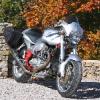








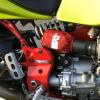
.jpg.c7ededca70acf94f9bc2797a8df95de8.jpg)
.jpg.005bb4ae11a8cfa2b39dc65ab88906ca.jpg)
